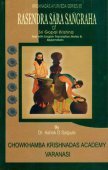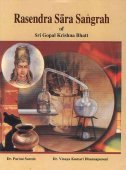Kharpara: 14 definitions
Introduction:
Kharpara means something in Hinduism, Sanskrit, Marathi. If you want to know the exact meaning, history, etymology or English translation of this term then check out the descriptions on this page. Add your comment or reference to a book if you want to contribute to this summary article.
In Hinduism
Ayurveda (science of life)
Rasashastra (Alchemy and Herbo-Mineral preparations)
Source: Wisdom Library: Rasa-śāstra1) Kharpara (खर्पर) is another name for Rasaka (“Calamine” or “Zinc ore”), which is part of the mahārasa group of minerals, according to the Rasaprakāśasudhākara: a 13th century Sanskrit book on Indian alchemy, or, Rasaśāstra.
2) Kharpara (खर्पर) is a sanskrit technical term translating to “Iron pan”. It is used throughout Rasaśāstra literature, such as the Rasaprakāśasudhākara or the Rasaratna-samuccaya.
Source: archive.org: Rasa-Jala-Nidhi: Or Ocean of indian chemistry and alchemyKharpara refers to “calamine”. (see Bhudeb Mookerji and his Rasajalanidhi)
Unclassified Ayurveda definitions
Source: Wisdom Library: Āyurveda and botanyKharpara (खर्पर) is a Sanskrit technical term, roughly corresponding to “baked clay”. It is found throughout Ayurvedic literature, such as the Suśruta-saṃhitā.
Source: Ancient Science of Life: Vaidyavallabha: An Authoritative Work on Ayurveda TherapeuticsKharpara (खर्पर) refers to “zinc carbonate”, and is dealt with in the 17th-century Vaidyavallabha written by Hastiruci.—The Vaidyavallabha is a work which deals with the treatment and useful for all 8 branches of Ayurveda. The text Vaidyavallabha has been designed based on the need (viz., kharpara) of the period of the author, availability of drugs during that time, disease manifesting in that era, socio-economical-cultural-familial-spiritual-aspects of that period Vaidyavallabha.
Source: gurumukhi.ru: Ayurveda glossary of termsKharpara (खर्पर):—One of the mineral of zinc

Āyurveda (आयुर्वेद, ayurveda) is a branch of Indian science dealing with medicine, herbalism, taxology, anatomy, surgery, alchemy and related topics. Traditional practice of Āyurveda in ancient India dates back to at least the first millenium BC. Literature is commonly written in Sanskrit using various poetic metres.
Shaktism (Shakta philosophy)
Source: Google Books: ManthanabhairavatantramKharpara (खर्पर) refers to a “skull”, according to the Manthānabhairavatantra, a vast sprawling work that belongs to a corpus of Tantric texts concerned with the worship of the goddess Kubjikā.—Accordingly, “Desirous of success (siddhi), he wanders constantly (all over) the country, (as freely) as he desires. If he is one who in his Kaula practice is a renouncer (caryāvadhūta), he should wander in (each) sacred seat and field, (one by one) in due order. The yogi who, by virtue of the intensity of the Command (bestowed upon him) desires success, should take a skull (kharpara) (to use for eating his) meals and (his) belongings. (This) Lord of Yogis should always live in an abandoned temple”.

Shakta (शाक्त, śākta) or Shaktism (śāktism) represents a tradition of Hinduism where the Goddess (Devi) is revered and worshipped. Shakta literature includes a range of scriptures, including various Agamas and Tantras, although its roots may be traced back to the Vedas.
Languages of India and abroad
Marathi-English dictionary
Source: DDSA: The Molesworth Marathi and English Dictionarykharpara (खर्पर).—m S An earthen bowl or a shelving dish; the lower portion of a pitcher; serving as a beggar's bowl, a chafing dish &c.
Marathi is an Indo-European language having over 70 million native speakers people in (predominantly) Maharashtra India. Marathi, like many other Indo-Aryan languages, evolved from early forms of Prakrit, which itself is a subset of Sanskrit, one of the most ancient languages of the world.
Sanskrit dictionary
Source: DDSA: The practical Sanskrit-English dictionaryKharpara (खर्पर).—
1) A thief.
2) A rogue, cheat.
3) A beggar's bowl.
4) The skull.
5) A piece of a broken jar, potsherd.
6) An umbrella.
-ram = खर्परी (kharparī) q. v.
Derivable forms: kharparaḥ (खर्परः).
Source: Cologne Digital Sanskrit Dictionaries: Edgerton Buddhist Hybrid Sanskrit DictionaryKharpara (खर्पर).—nt. (= Prakrit khappara, see [Paia-sadda-mahaṇṇavo]; Sanskrit Lex. kharpara and karpara; in Sanskrit lit. karpara, bowl, and [Page204-a+ 71] once in late Sanskrit kharpara, said to mean shell of a tortoise, Schmidt, Nachträge; compare next), (skull,) head: Divyāvadāna 324.11 kharparam (so read with v.l., ed. kharpam) idaṃ gṛhāṇa (referring to uttamāṅgam in prec. line).
Source: Cologne Digital Sanskrit Dictionaries: Cappeller Sanskrit-English DictionaryKharpara (खर्पर).—[neuter] ī [feminine] a cert. mineral.
Source: Cologne Digital Sanskrit Dictionaries: Monier-Williams Sanskrit-English Dictionary1) Kharpara (खर्पर):—m. a thief, [cf. Lexicographers, esp. such as amarasiṃha, halāyudha, hemacandra, etc.]
2) a rogue, cheat, [cf. Lexicographers, esp. such as amarasiṃha, halāyudha, hemacandra, etc.]
3) the skull, [cf. Lexicographers, esp. such as amarasiṃha, halāyudha, hemacandra, etc.]
4) the half of a skull, [Horace H. Wilson]
5) a beggar’s bowl or dish, [cf. Lexicographers, esp. such as amarasiṃha, halāyudha, hemacandra, etc.]
6) an umbrella or parasol, [cf. Lexicographers, esp. such as amarasiṃha, halāyudha, hemacandra, etc.]
7) Name of a man, [Vīracarita xviii]
8) n. and f(ī). a kind of mineral substance (used as a collyrium), [Bhāvaprakāśa v, 7, 145; 26, 118 and 232] (cf. karpara.)
[Sanskrit to German]
Sanskrit, also spelled संस्कृतम् (saṃskṛtam), is an ancient language of India commonly seen as the grandmother of the Indo-European language family (even English!). Closely allied with Prakrit and Pali, Sanskrit is more exhaustive in both grammar and terms and has the most extensive collection of literature in the world, greatly surpassing its sister-languages Greek and Latin.
Kannada-English dictionary
Source: Alar: Kannada-English corpusKharpara (ಖರ್ಪರ):—
1) [noun] the bone framework or skeleton of the head, esp. that part enclosing the brain, in people; the skull.
2) [noun] the hard upper shell of a tortoise; the carapace.
3) [noun] a large deep bowl-shaped vessel for boiling over an open fire; an ornamental vessel resembling this; a cauldron.
4) [noun] a beggar’s bowl; an alms-vessel.
5) [noun] a light portable device for protection against rain, strong sun, etc., consisting of a usu. circular canopy of cloth mounted by means of a collapsible metal frame on a central stick; an umbrella.
6) [noun] a broken piece of an earthen-pot.
7) [noun] a man who steals, esp. secretly and without violence; a thief.
8) [noun] a wicked man.
9) [noun] name of a province in India.
Kannada is a Dravidian language (as opposed to the Indo-European language family) mainly spoken in the southwestern region of India.
See also (Relevant definitions)
Starts with: Kharparala, Kharparasutra.
Ends with: Brahmandakharpara, Vishakharpara.
Full-text: Nirmuta, Kharparika, Kharpari, Kharparirasaka, Rasaka, Kharparituttha, Brahmandakharpara, Nakshatracakra, Khapara, Karpara, Maharasa.
Relevant text
Search found 7 books and stories containing Kharpara; (plurals include: Kharparas). You can also click to the full overview containing English textual excerpts. Below are direct links for the most relevant articles:
Rasa Jala Nidhi, vol 2: Minerals (uparasa) (by Bhudeb Mookerjee)
Part 4 - Incineration of kharpara < [Chapter VII - Uparasa (8): Rasaka or Kharpara (calamine)]
Part 3 - Purification of kharpara < [Chapter VII - Uparasa (8): Rasaka or Kharpara (calamine)]
Part 2 - How rasaka may be made to stand fire < [Chapter VII - Uparasa (8): Rasaka or Kharpara (calamine)]
Rasa Jala Nidhi, vol 1: Initiation, Mercury and Laboratory (by Bhudeb Mookerjee)
Part 1 - Additional process for transformation of base metals into gold and silver < [Chapter VIII - Conclusion of first volume]
Part 2 - Alchemical crucibles (musa) < [Chapter VI - Laboratory equipment]
Part 19 - Mercurial operations (17): Dyeing of mercury (ranjana) < [Chapter IV-V - Mercurial operations]
Atharvaveda and Charaka Samhita (by Laxmi Maji)
Rasendrasāra Saṅgraha (Āyurveda book) < [Chapter 1 - Introduction]
Yoga Vasistha [English], Volume 1-4 (by Vihari-Lala Mitra)
Chapter CXXVII - Cosmology of the universe < [Book VII - Nirvana prakarana part 2 (nirvana prakarana)]
Varahi Tantra (English Study) (by Roberta Pamio)
Chapter 12 - The Dhyānas (supports for the meditation) of the Goddess < [Summary of the Vārāhī Tantra]
Sushruta Samhita, volume 2: Nidanasthana (by Kaviraj Kunja Lal Bhishagratna)
Related products




